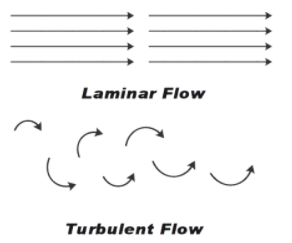
Define turbulent flow.
Answer
566.1k+ views
Hint: In this question, we are asked to define turbulent flow. Therefore, we shall first define turbulence. We shall also discuss the definition of turbulent flow. We shall discuss the reasons for the flow to be turbulent and also the ways of detecting the turbulent flow. We shall also briefly discuss other types of flow.
Complete answer:
Turbulence is the chaotic change in flow of something. When a flow of fluid such as gas or water undergoes irregular fluctuations or mixing, the fluid is said to be in turbulent flow. The turbulent flow occurs due to excessive kinetic energy in parts of fluid flow, which overcomes the effect of damping of the viscosity of fluid. Due to this reason turbulence mostly occurs in the low viscosity fluids.

The flow of fluid is said to be in turbulent motion if the Reynold’s number of the flow is greater than 4000. Reynold’s number is defined as the ratio of inertial forces to viscous forces for a fluid that is subjected to relative internal movement due to different velocities of fluid.
The opposite of turbulent flow is laminar flow. When the particles in fluid follow a smooth path in layers, with each layer moving smoothly past the adjacent layer, it is then known as Laminar flow. For a fluid flow to be laminar the Reynold’s number should be less than 2100.
Note:
The daily examples of turbulent flow are: the flow of smoke through chimneys, or the fast flowing river. The region where the flows change their behaviour is known as the boundary layer. The Reynold’s number is a dimensionless number that is used to tell the difference in laminar and turbulent flow. It is also used to predict the nature of flow. Reynold’s number is given by,
\[\operatorname{Re}=\dfrac{\rho VL}{\mu }\].
Complete answer:
Turbulence is the chaotic change in flow of something. When a flow of fluid such as gas or water undergoes irregular fluctuations or mixing, the fluid is said to be in turbulent flow. The turbulent flow occurs due to excessive kinetic energy in parts of fluid flow, which overcomes the effect of damping of the viscosity of fluid. Due to this reason turbulence mostly occurs in the low viscosity fluids.

The flow of fluid is said to be in turbulent motion if the Reynold’s number of the flow is greater than 4000. Reynold’s number is defined as the ratio of inertial forces to viscous forces for a fluid that is subjected to relative internal movement due to different velocities of fluid.
The opposite of turbulent flow is laminar flow. When the particles in fluid follow a smooth path in layers, with each layer moving smoothly past the adjacent layer, it is then known as Laminar flow. For a fluid flow to be laminar the Reynold’s number should be less than 2100.
Note:
The daily examples of turbulent flow are: the flow of smoke through chimneys, or the fast flowing river. The region where the flows change their behaviour is known as the boundary layer. The Reynold’s number is a dimensionless number that is used to tell the difference in laminar and turbulent flow. It is also used to predict the nature of flow. Reynold’s number is given by,
\[\operatorname{Re}=\dfrac{\rho VL}{\mu }\].
Recently Updated Pages
Why is there a time difference of about 5 hours between class 10 social science CBSE

In cricket, what is a "pink ball" primarily used for?

In cricket, what is the "new ball" phase?

In cricket, what is a "death over"?

What is the "Powerplay" in T20 cricket?

In cricket, what is a "super over"?

Trending doubts
What are the major means of transport Explain each class 12 social science CBSE

Which are the Top 10 Largest Countries of the World?

Draw a labelled sketch of the human eye class 12 physics CBSE

How much time does it take to bleed after eating p class 12 biology CBSE

Explain sex determination in humans with line diag class 12 biology CBSE

Explain sex determination in humans with the help of class 12 biology CBSE




